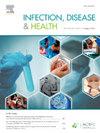Bacterial bloodstream infections in a pediatric population: A 7-year experience at a tertiary care center in Saudi Arabia
IF 2
Q2 PUBLIC, ENVIRONMENTAL & OCCUPATIONAL HEALTH
引用次数: 0
Abstract
Objectives
This study explored the epidemiological trends and antimicrobial susceptibility patterns of bloodstream pathogens among pediatric patients over a 7-year period at a tertiary care facility in Saudi Arabia.
Methods
This retrospective single-center longitudinal descriptive study was conducted from 2015 to 2021. Blood culture and susceptibility data of pathogens isolated from patients aged <15 years were extracted from the hospital's laboratory information system. The trends observed over the 7-year period were graphically illustrated.
Results
Among the 83,605 pediatric blood cultures analyzed, 2945 (3.5 %) tested positive. Approximately 65 % of the positive cultures were confirmed as true bloodstream infections (BSIs), with an average BSI rate of 3 per 1000 inpatient days. Gram-negative bacterial infections accounted for 61 % of BSIs, with Klebsiella spp. being the most prevalent. Susceptibility testing revealed reduced sensitivity to meropenem, imipenem, ciprofloxacin, and levofloxacin among gram-negative bacteria. Gram-positive pathogens represented 39 % of infections, with the most common being Staphylococcus spp. (21 %) and Streptococcus spp. (7 %). Methicillin-resistant Staphylococcus aureus exhibited 100 % sensitivity to vancomycin, quinupristin/dalfopristin, tigecycline, and linezolid. However, Streptococcus pneumoniae showed decreasing sensitivity to penicillin and ceftriaxone for meningitis (33 % and 55 % susceptibility, respectively). Furthermore, Enterococcus spp. were less susceptible against ampicillin, linezolid, levofloxacin, and vancomycin.
Conclusions
The findings of this study offer crucial insights into the incidence of pediatric bacteremia and trends in antibiotic susceptibility, which can inform treatment strategies, guide antibiotic stewardship programs, and enhance infection control measures in healthcare settings.
细菌性血流感染在儿科人群:在沙特阿拉伯三级保健中心7年的经验。
目的:本研究探讨了沙特阿拉伯一家三级医疗机构7年来儿科患者血液病原体的流行病学趋势和抗菌药物敏感性模式。方法:2015 - 2021年进行回顾性单中心纵向描述性研究。结果:83,605例儿童血培养物中,阳性2945例(3.5%)。大约65%的阳性培养被确认为真正的血流感染(BSI),平均BSI率为每1000个住院日3例。革兰氏阴性细菌感染占bsi的61%,以克雷伯氏杆菌最为普遍。药敏试验显示革兰氏阴性菌对美罗培南、亚胺培南、环丙沙星和左氧氟沙星的敏感性降低。革兰氏阳性病原体占感染的39%,其中最常见的是葡萄球菌(21%)和链球菌(7%)。耐甲氧西林金黄色葡萄球菌对万古霉素、奎奴普汀/达佛普汀、替加环素和利奈唑胺100%敏感。然而,肺炎链球菌对青霉素和头孢曲松治疗脑膜炎的敏感性下降(分别为33%和55%)。此外,肠球菌对氨苄西林、利奈唑胺、左氧氟沙星和万古霉素的敏感性较低。结论:本研究结果为儿童菌血症发生率和抗生素敏感性趋势提供了重要见解,可以为治疗策略提供信息,指导抗生素管理计划,并加强医疗机构的感染控制措施。
本文章由计算机程序翻译,如有差异,请以英文原文为准。
求助全文
约1分钟内获得全文
求助全文
来源期刊

Infection Disease & Health
PUBLIC, ENVIRONMENTAL & OCCUPATIONAL HEALTH-
CiteScore
5.70
自引率
5.70%
发文量
40
审稿时长
20 days
期刊介绍:
The journal aims to be a platform for the publication and dissemination of knowledge in the area of infection and disease causing infection in humans. The journal is quarterly and publishes research, reviews, concise communications, commentary and other articles concerned with infection and disease affecting the health of an individual, organisation or population. The original and important articles in the journal investigate, report or discuss infection prevention and control; clinical, social, epidemiological or public health aspects of infectious disease; policy and planning for the control of infections; zoonoses; and vaccination related to disease in human health. Infection, Disease & Health provides a platform for the publication and dissemination of original knowledge at the nexus of the areas infection, Disease and health in a One Health context. One Health recognizes that the health of people is connected to the health of animals and the environment. One Health encourages and advances the collaborative efforts of multiple disciplines-working locally, nationally, and globally-to achieve the best health for people, animals, and our environment. This approach is fundamental because 6 out of every 10 infectious diseases in humans are zoonotic, or spread from animals. We would be expected to report or discuss infection prevention and control; clinical, social, epidemiological or public health aspects of infectious disease; policy and planning for the control of infections; zoonosis; and vaccination related to disease in human health. The Journal seeks to bring together knowledge from all specialties involved in infection research and clinical practice, and present the best work in this ever-changing field. The audience of the journal includes researchers, clinicians, health workers and public policy professionals concerned with infection, disease and health.
 求助内容:
求助内容: 应助结果提醒方式:
应助结果提醒方式:


